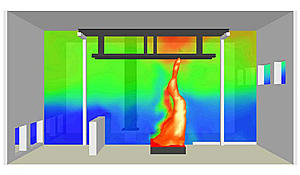Blast and Impact Events

Computer simulation based on a NIST fire test conducted during the investigation of the collapse of the World Trade Center towers. Image shows flames impacting a model of a WTC steel floor truss without any fire-resistant insulation. Colors in the simulation show the variation in gas temperatures.
World Trade Center Terrorist Attack, New York, September 11, 2001
On August 21, 2002, with funding from the U.S. Congress through FEMA, the NIST announced its building and fire safety investigation of the World Trade Center (WTC) disaster that occured on September 11, 2001.
The study concluded that the tragic consequences of the September 11, 2001, attacks were directly attributable to the fact that terrorists flew large jet-fuel laden commercial airliners into the WTC towers. NIST has compiled a list of recommendations to improve the safety of tall buildings, occupants, and emergency responders based on its investigation of the procedures and practices that were used for the WTC towers; these procedures and practices are commonly used in the design, construction, operation, and maintenance of buildings under normal conditions.
More Studies:

